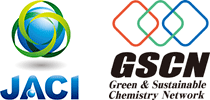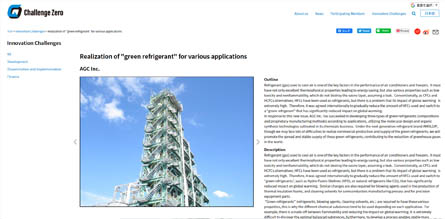 HFCs Supporting Lifestyles and Industrial Society
HFCs Supporting Lifestyles and Industrial Society
Used as air conditioning refrigerants
and cleaning solvents,
hydrofluorocarbons (HFCs) have helped to maintain
our lifestyles and industrial society.
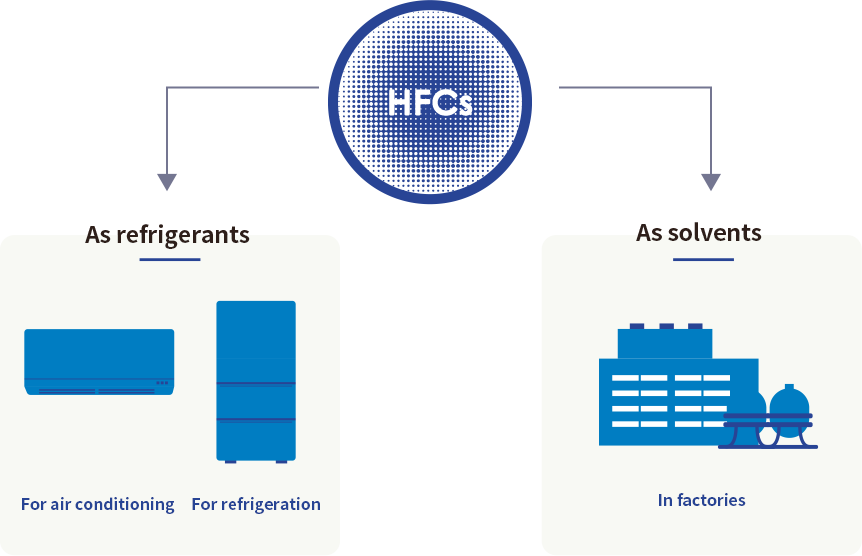
Specified chlorofluorocarbons (CFCs) have excellent properties and were once used globally as refrigerants and for a wide range of other purposes. Unfortunately, scientists discovered that specified CFCs were causing environmental problems by damaging the ozone layer. An international agreement* was signed with the aim of ending production of specified CFCs in major countries by the end of 1995. The emergence of hydrochlorofluorocarbons (HFCs) as an alternative to CFCs was instrumental in halting anthropogenic damage to the ozone layer. HFCs are still used as refrigerants in air conditioners, freezers, and refrigerators, and as cleaning solvents in manufacturing processes. Used for a wide range of purposes, these chemical products play a key role in our lifestyles and society.
* The Montreal Protocol
 The Problem with HFCs
The Problem with HFCs
HFCs are involved in global warming.
Their global warming potential (GWP) is
around 2,000 times greater than that of CO2.
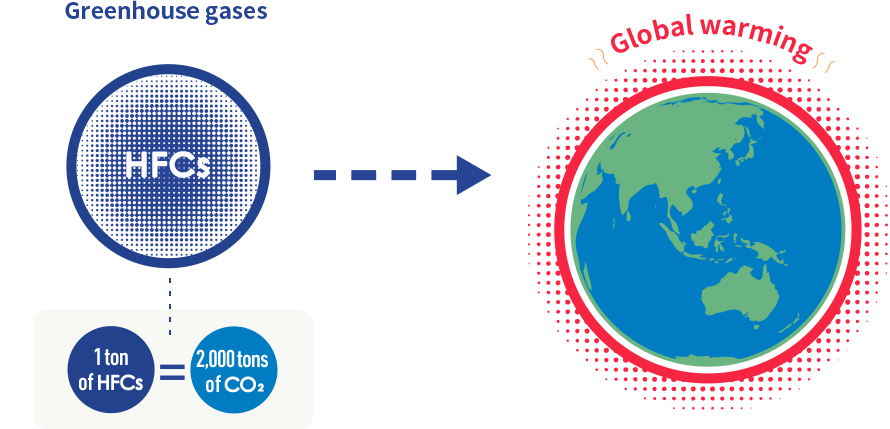
Global warming is caused by six greenhouse gases, including carbon dioxide and methane. Carbon dioxide has had a particularly serious impact in the modern world because of the use of fossil fuels, such as oil, coal, and natural gas, as primary sources of energy. A major disadvantage with HFCs, which have been widely used as alternatives to specified CFCs, is their extremely high global warming potential (GWP). The GWP of HFCs is around 2,000 times higher* than that of carbon dioxide.
* The GWP of the refrigerant used in common room air conditioners (R410A) is 2,090 times higher than that of CO2.
 HFC Reduction Plan
HFC Reduction Plan
HFCs contribute to global warming,
and their use is being phased out globally.
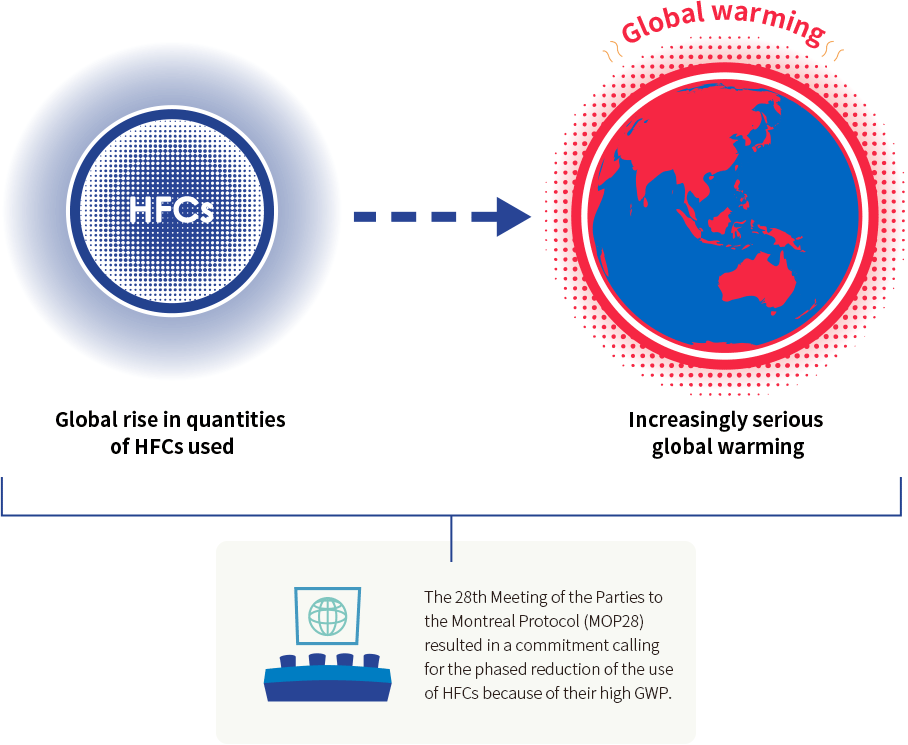
In response to the global warming problem, the international community made a commitment to the phased reduction of the use of high-GWP HFCs in both developed and developing countries*. Adopted in 2016, this reduction plan calls for an 80% reduction in HFC use in advanced countries by 2036, and in developing countries by 2047. In addition to efforts to achieve these goals, the international community is increasingly calling for the development of new alternatives to specified CFCs.
* The Kigali Amendment to the Montreal Protocol was adopted at the 28th Meeting of the Parties to the Montreal Protocol.
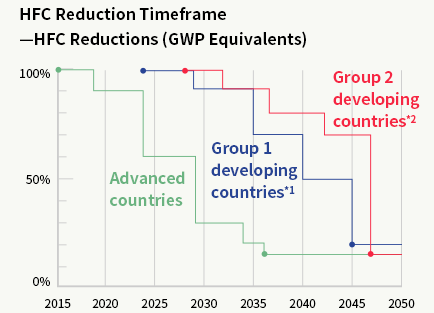 *1 Developing countries other than those included in Group 2
*1 Developing countries other than those included in Group 2
*2 India, Pakistan, Iran, Iraq, Gulf states
 The Potential of HFOs
The Potential of HFOs
Hydrofluoroolefins (HFOs) are attracting
intense interest in the search for new chemicals
to solve the global warming problem.
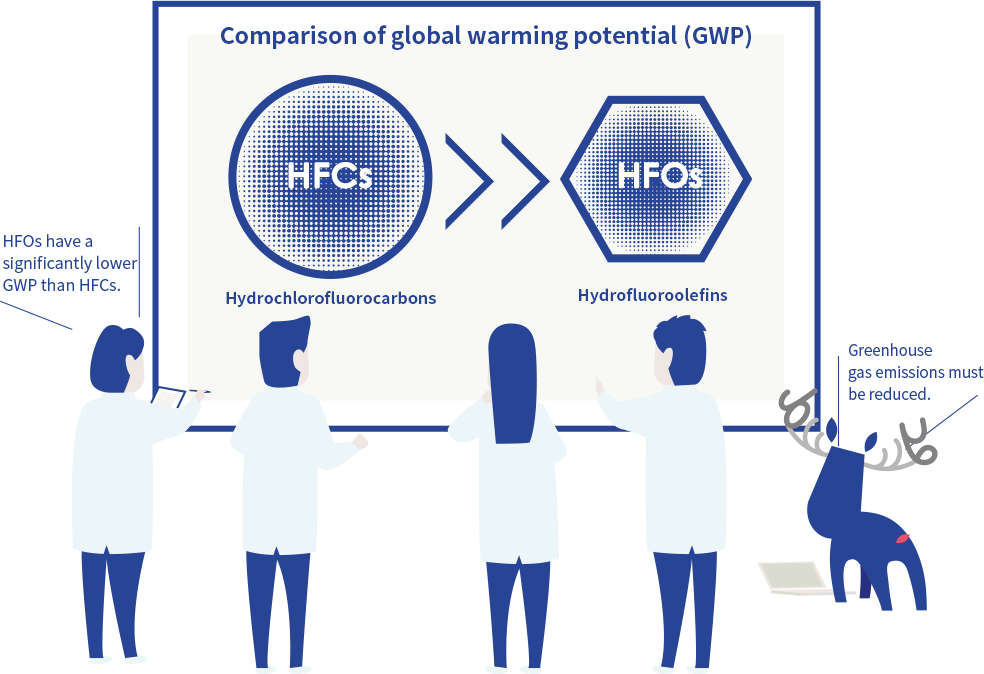
In response to rising international expectations toward the development of low-GWP alternatives, AGC began to explore the potential of hydrofluoroolefins (HFOs). Compared with HFCs, HFOs have extremely low single-digit GWPs. By commercializing these products, AGC would be able to make a major contribution to the reduction of greenhouse gas emissions. We began to develop products targeting key applications for which substantial quantities of HFCs are used, specifically HFC-134a, HFC-245fa, and AK-225. Our goal was to contribute to the solution of the climate change problem by developing HFC alternatives that would substantially reduce greenhouse gas emissions.
 The Birth of the AMOLEA™ Series
The Birth of the AMOLEA™ Series
The AMOLEA™ Series—environmentally-friendly
HFOs with low GWPs
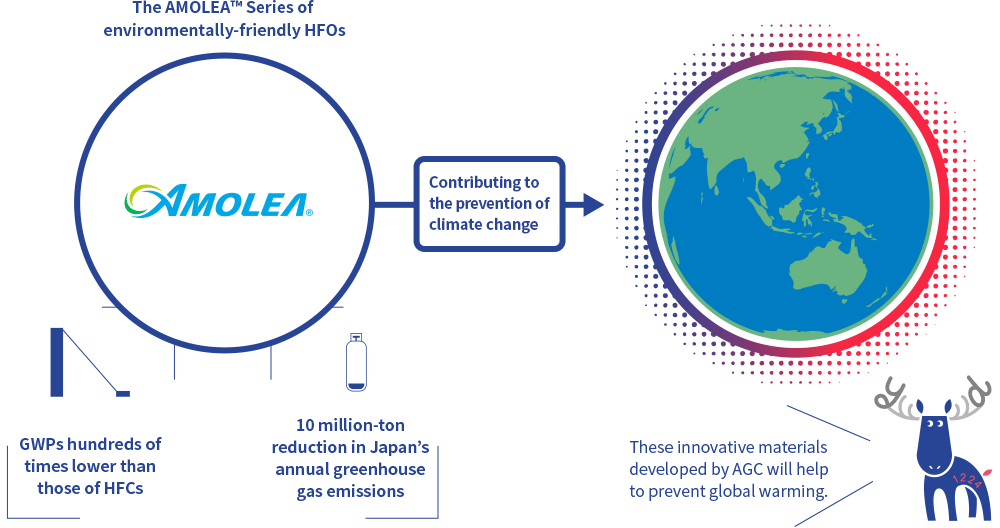
In 2018, AGC established an industrial production method for HFOs and commenced production in a commercial plant. We selected three HFOs with saturated bonds in their molecules—HFO-1234 yf, HFO-1224 ydZ, and AS-300—as new HFC-alternatives and began to market these substances commercially as the AMOLEA™ Series.
The AMOLEA™ Series of chemical products have extremely low GWP values while maintaining the same boiling points and safety characteristics as earlier products. Their GWPs are several hundred times lower than existing refrigerants or foaming agents, and by replacing earlier products with AMOLEA™ Series products, it will be possible to reduce environmental loads based on life cycle assessment (LCA) to around one-tenth. Just within Japan, this change has the potential to reduce greenhouse gas emissions by the equivalent of over 10 million tons* of CO2 per year.
* Based on the replacement of all HFC134a and HFC245fa used in Japan with AGC’s HFO products (AMOLEA™ 1234yf, AMOLEA™ 1224yd)




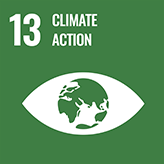











 An environmentally-friendly fluorine refrigerant for use in air conditioners, freezers, and also as a foaming and pipe cleaning agent, and for various other applications
An environmentally-friendly fluorine refrigerant for use in air conditioners, freezers, and also as a foaming and pipe cleaning agent, and for various other applications A next-generation nonflammable solvent that combines low environmental loads with excellent cleaning performance
A next-generation nonflammable solvent that combines low environmental loads with excellent cleaning performance